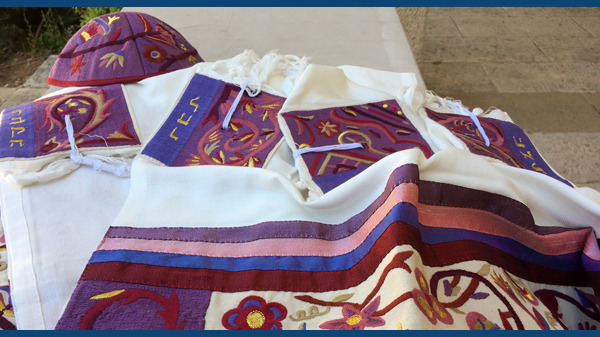Rabbi Stacey Blank | Kehilat Shir Chadash, Tzur Hadassah, Israel

In Israel, it is common for girls to mark bat mitzvah with a party or other kind of special celebration. Though it is still unusual, there are more and more young women who mark their twelfth birthday with a ceremony in the synagogue in which they read from the Torah. Preparing for such a ceremony recently, I asked if the bat mitzvah will wear a tallit for the ceremony. When she hesitated, I explained that today tallitot come in a variety of colors, designs, and materials – like a pink silk tallit. When she heard this, the bat mitzvah got very excited and she and her mother planned an outing to the local Judaica store to find a tallit. Also, young men beam with excitement when their parents present them with a beautiful tallit woven with silver strands and adorned with crowns or representations of Jerusalem.
When we present the tallit during the bar/bat mitzvah ceremony, I explain that the mitzvah is the tzitzit, the fringes on the corners of the tallit. The tallit itself is a beautiful garment that is called hiddur mitzvah, the beautification or enhancement of the mitzvah.
I have observed that when something is beautiful, it takes on greater meaning for us, we take more care with it, and it fills us with a special feeling.
In this week’s Torah portion, Terumah, G-d commands Moses to take a contribution from all the Israelites and presents him with the blueprints for the Tabernacle, the movable center of worship for the Israelites in the wilderness. The portion outlines the structure and gives many details about the elaborate and colorful decorations and design. For example, we can see in the opening verses (Exodus 25:3-7):
“And these are the gifts that you shall accept from them: gold, silver, and copper; blue, purple, and crimson yarns, fine linen, goats’ hair; tanned ram skins, tachash skins, and acacia wood; oil for lighting, spices for the anointing oil and for the aromatic incense; lapis lazuli and other stones for setting, for the ephod and for the breastpiece.”
It seems that the building of the Tabernacle is in itself an act of hiddur mitzvah.
We learn about this concept from the Talmud (Shabbat 133b). It is written that the Sages evoke the verse from the jubilant Song of Sea where Moses exclaims, (Exodus 15:2), “This is my G-d and I will adorn Him.” From this we learn that each of us must “adorn” ourselves before G-d in the fulfillment of mitzvot. This idea of beautifying our acts of mitzvot has since become an established value, some commentators saying that act of beautifying is a mitzvah in and of itself!
The traditional understanding of hiddur mitzvah is that of investing money in beautiful ritual objects – a kiddush cup, a perfect etrog for Sukkot, tefillin, etc. Nice things make us feel good. I agree with this, as I gave the example of the tallit above.
However, I believe that concept of hiddur mitzvah goes deeper even to the very core of Jewish identity. The goal of hiddur mitzvah is to enrich our Jewish practice and bring deeper meaning and spiritual elevation to our lives. When we take an act, a place, or people for granted or relate to them without giving much thought, we are on a slippery slope to losing respect for them which can lead to neglect or disdain. When we take care of our synagogues, we enhance their ability to be a home to our values. When we pray in our communities, if we pray only because we are told to do it, it can become a hateful task. When we incorporate melodies, bring contemporary poetry and take moments to focus our intention, these help prayer to be an uplifting, deeply spiritual experience.
Hiddur Mitzvah is not only an external, physical act but can also be a great force for personal flourishing. The midrash (Song of Songs Rabba 1:15) teaches that the meaning of the verse “Behold my dear one, you are beautiful” is more than physical beauty. Some examples that it gives of true beauty are such:
You are beautiful in the performance of mitzvot,
You are beautiful in the performance of acts of loving kindness….
You are beautiful in giving contributions…
You are beautiful in providing the needy with food….
You are beautiful in providing acts of sustenance…
Hiddur Mitzvah is also about developing our inner beauty. When we are kind and generous, we become more beautiful. When we go out of our way to not only allow new people into our communities, but also take interest in them and invite them into our homes, then we have made the value of hachnasat orchim (welcoming guests) even more beautiful.
Obligation has an important role to play in our decisions and in our acts. Commitment to an idea, an organization, or to a person keeps me going when things are challenging and frustrating. That being said, if Judaism is only about obligation, it can become a burden and become hateful. When I do something because it brings me joy and fills me with meaning, it becomes a part of who I am. It lightens the burden. It connects me to the greater good while allowing my individual and unique identity to shine.
The Tabernacle has also been compared as a blueprint for our souls. The adornments of the Tabernacle – such as the golden menorah, the stone altar, the colorful curtains, the Ark of the Covenant – created a sense of awe and connection. The adornments of our soul – such as insight, wisdom, ethics, aesthetics, generosity, love – make a person a holy vessel with the capacity to make the world and humanity truly beautiful.
The views and opinions expressed in this article are those of the author(s) and do not necessarily reflect the official policy or position of the World Union for Progressive Judaism (WUPJ).
